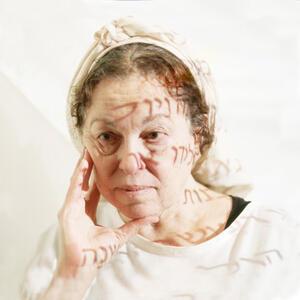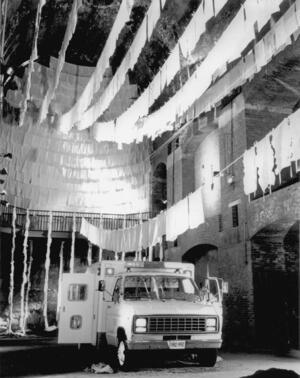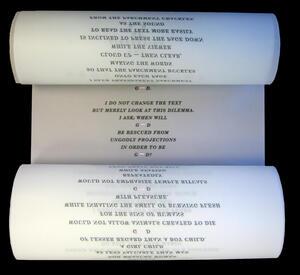Helène Aylon
Multimedia artist Helene Aylon began by creating process art in the 1970s; by the 1980s, she focused on anti-nuclear and eco-activist art, which she more specifically called eco-feminist art. She subsequently devoted more than 35 years to the multi-partite installation The G-d Project. This body of work’s textuality resonates from and responds to Judaism’s traditionally male-dominated textuality as part of a larger, detailed commentary on women in Judaism. It reflects her knowledge base as well as her profound challenges in growing up in and out of an Orthodox upbringing. There is no more significant articulator of the question of where, in fitting into the history of Western, Christian art as Jewish and female artists, women fit into the history of Judaism.
Helène Aylon was an American multimedia artist who began by creating “process art” in the 1970s, focused on anti-nuclear and eco-activist art by the 1980s, and subsequently devoted more than 35 years to the multi-partite installation The G-d Project. The often direct or indirect textuality within this last body of work resonates from and responds to Judaism’s traditionally male-dominated textuality as part of a larger commentary on the place of women in Judaism.
Early Biography
Aylon was born on February 4, 1931, in Brooklyn, NY, to Anshel Greenfield, who ran a tie factory, and Etta (Scheinberg) Greenfield, a homemaker. She had two younger sisters: Sandy (b. 1936) and Linda (b. 1942). Aylon was raised as an Orthodox Jew, attending grade school at Shulamith School for Girls and a religious high school—although she had wanted to attend The High School of Music and Art (Aylon 2012: 40-2). While attending high school, she became engaged to a rabbinical student, Mandel H. Fisch (1926-1961). They married in 1949 and lived in Montreal, where Mandel was already serving as a rabbi. A year later Aylon gave birth to a son, Nathaniel, followed soon by a daughter, Renee Emunah; the couple returned to Brooklyn while Aylon was pregnant with Renee. She began studying art at Brooklyn College, under Ad Reinhardt, through whom she also met—and discussed Judaism and art—with Mark Rothko.
Aylon’s husband, after battling cancer for five years, died in 1961; Aylon was 30. Two years later, she volunteered to paint a mural for a community center in the Bedford-Stuyvesant neighborhood in Brooklyn. When a New York Journal American newspaper reporter interviewed her, she said spontaneously that her name was Helène Aylon, adopting the Hebraized version of her first name as her surname. The artist’s first paid commission was a sixteen-foot mural for the Jewish chapel at New York’s JFK International Airport; Ruach (Spirit/Wind/Breath; 1965-1966) layered that word’s three Hebrew letters like a gigantic palimpsest embodying blueness, blackness, and redness. By 1970, she was showing work in one-person exhibits at the Max Hutchinson Gallery in SoHo.
Process Art
Swept up by the emerging feminist movement, Aylon moved in 1973 to San Francisco, teaching at San Francisco State University and the California College of Arts and Crafts in Oakland. She began to explore Process Art, creating a series called Paintings That Change in Time (1974-1977), all of which used oil on paper that would slowly transform as the oil slithered along the surface. This act imposed pure chance onto the process of shaping the image and yielded a sense of abstract sky-and-seascapes. These and other works were exhibited at Betty Parsons Gallery and elsewhere in 1975 and 1979.
Aylon’s method was already expanding by 1978 with the series called The Breakings. For these she placed large panels on the floor and poured linseed oil on them to form a thick carapace. Months later, she tilted the panels so that gravity would pull the oil toward the bottom, creating thicker sacs that would typically burst, by chance, creating what she called “very wet, orgasmic process art… I intentionally made paintings that change through natural means, such as a plant that grows, a face that wrinkles, a scar that heals” (Aylon 2012: 166)
Eco-Feminism
By the late 1970s, Aylon was distinctly referring to herself as an eco-feminist. Leaving the studio behind, she began to create anti-nuclear and eco-activist art. From Pacific [Ocean] Sand Gathering she moved to Earth Ambulance, a converted truck that symbolized an attempt to save the world from nuclear war. Using the Earth Ambulance, Aylon gathered dirt from SAC [Strategic Air Command] nuclear bases, uranium mines, and nuclear reactor sites across the United States. She stuffed the dirt into pillowcases, which she used in a demonstration at the United Nations during the Second Special Session on Nuclear Disarmament on June 12, 1982. The pillowcases were ceremoniously carried down the steps of Ralph Bunche Park on army stretchers.
In 1992, to celebrate the end of the Cold War, Aylon installed the seed-filled Earth Ambulance at the Brooklyn Bridge Anchorage, an alternative arts space in New York City. Pillowcases from previous projects were hung around the installation. For Bridge of Knots, Aylon created chains of knotted pillowcases, inscribed with dreams and nightmares about nuclear war, and draped them around the façades of the Knoxville Museum of Art in 1993, Berkeley Art Museum in 1995, and American University’s Katzen Art Museum in 2006.
In 1985, Aylon traveled to Japan on the 40th anniversary of the atomic bombings of Hiroshima and Nagasaki. Sacks of seeds, grain, pods, and bamboo were floated down the Kama River toward those two cities. In 1995, Aylon's video of the “Two Sacks En Route” to Hiroshima and Nagasaki was shown on the Sony Jumbotron in Times Square.
The G-d Project
Soon after the death of her husband in 1961, as she struggled to balance being a single mother with being an aspiring artist, Aylon began to reject the patriarchal notions that dominate the Torah. Her ideas began to percolate more intensely—interweaving the Jewish question of fitting in to Western (largely Christian) art with the question of where women fit within both art and Judaism—just before her son’s wedding in 1984, when they visited her husband’s grave. She noticed, perhaps for the first time, that the inscription referred to him as the son of his father—but with no mention of his mother. Aylon realized also that her traditional wedding contract (Marriage document (in Aramaic) dictating husband's personal and financial obligations to his wife.ketubbah), which connected her to her husband at the beginning of their life together, mirrored this feature, offering both of their names and referring to their respective fathers but not to their mothers—and that the illuminated ketubbah that her son had asked her to create for him would also make no mention of her, despite the fact that she had borne and almost single-handedly raised him.
These realizations ultimately led to The G-d Project, a nine-part series of installations created over a 37-year period. Beginning with the first part, created between 1990 and1996, the Project became an act of subversion that would engage and challenge tradition and traditional texts and their readings. The first installation, “The Liberation of G-d” (with the hyphen colored pink), presented the Torah as five open books, in English and Hebrew, seated on velvet-covered stands. Each page was covered in translucent parchment. The recorded sound of turning parchment pages was played in a loop. Aylon placed the 54 sections into which the Torah is divided for public readings and study throughout the year along a wall just beyond the five books and used a pink highlighter to mark phrases that, she contended, convey patriarchal attitudes. She also targeted words or phrases describing vengeance, deception, cruelty, and misogyny, which have been falsely ascribed to God. Can God possibly have uttered the words that she excised, or must they derive from God’s misogynistic (or at least fearful-of-women) male conduits and interpreters?
In 1997, Aylon completed “The Women’s Section,” dedicated to women whose estranged husbands refuse to grant them a Jewish religious divorce (Hebrew: get), making it impossible for them to remarry. She included texts from the Torah that reference women’s “impurity” and “virginity.”
“My Notebooks,” completed in 1998, consists of 54 blank 8.5 × 11” open notebooks with blank, empty pages that formed a group of columns. Closed notebooks, with dark covers, formed black columns; open notebooks formed white columns. A transparency of photographs taken at Shulamith School at the time when Aylon was a student there was projected across the notebooks. The work was “Dedicated to Mrs. Rashi and to Mrs. Maimonides [wives of the preeminent medieval Jewish commentators], for surely they have something to say” and was intended to be a comment on “women’s lack of scholarship and participation in education,” while also alluding to the female teachers at Aylon’s all-female school, who were only permitted to teach commentary from male rabbis.
The fourth part of The G-d Project, Aylon’s 1999 “Epilogue: Alone with My Mother,” features a seven-foot-wide alcove with a pew, facing a stand with two open Bibles fixed so that they cannot close. In the Bibles, the blessings and curses of the last chapters of Deuteronomy are highlighted. A taped conversation between Aylon and her mother accompanies the installation, which is dedicated to her mother, who, until her death at nearly 101, remained close to Aylon despite not understanding her daughter’s need to be an artist. Aylon also created “My Bridal Chamber: My Marriage Contract,” the fifth work in the series, in 1999. It consists of a simple bed covered in a white bedspread that the artist constructed from handkerchiefs and a wedding canopy. Around it, four columns with superimposed projections of photographs show the artist in her wedding gown. Behind the headboard, passages from Leviticus mention women’s “uncleanliness” and “impurity.” The installation focused on marital and religious constraints felt by women.
The sixth work of The G-d Project, “My Bridal Chamber: My Marriage Bed/My Clean Days,” was created in 2000-2001. Aylon projected shifting images onto a white bedsheet to represent menstrual impurity, while a concatenation of voice recordings counted the waiting times between periods and ritual baths. In 2002, the seventh work, “The Partition Is in Place, but the Service Can’t Begin,” offered a wall comprised of tzitziyot (prayer-shawl fringes, traditionally worn by Jewish males but not females) and large photocopies of the Western Wall in Jerusalem. The piece comments on the segregation of male and female worshippers in Orthodox synagogues and at the Wall. The artist noted: “The material I thought appropriate for the partition that separates male and female worshippers is made of the ritual garb [the prayer shawl] worn by religious men. But if there were nine male worshippers and one thousand female worshippers, the service could not begin because the service requires the presence of ten men” (see Aylon 2012: 235).
Aylon created Wrestlers, the eighth G-d Project installation, in 2005, adapting a 1980 work. That earlier iteration had featured large-scale landscape photographs with herself as a tiny figure in them, searching for foremothers. The 2005 version added “another layer of meaning to the Wrestlers by focusing on one particular wrestling fore-mother—Lot’s Wife—and I gave her a name.” That name was “Hashemshela”—meaning “her name” in Hebrew (Aylon 2012: 236-7). Aylon dedicated Wrestlers to Ana Mendieta, the Cuban-American artist who was most likely pushed from a window to her death in 1985 by her husband, Carl Andre.
The ninth and final work was “All Rise: An Installation of a Lit. "house of judgement." Jewish court of lawBeit Din [“House of Judgment”] as a ‘House’ of Three Women” (2007). This work transforms that traditional male bastion into a question implicitly weaving together the Talmudic tractate Sanhedrin and the Talmudic order Nashim. Three high-backed chairs sit on a platform approached by three steps. The chairs represent the three male judges that, according to Sanhedrin, should make up a standard Bet Din that adjudicates everyday matters. The platform and its chairs are flanked by two flags—made of pink pillow-cases—and the chairs are decorated with fringes that resemble tzitziyot.
On the railing before the platform, two inscriptions explain the installation. The first reads:
Whereas
the Lit. "the prepared table." A code of Jewish Law compiled by Joseph Caro (1488Shulchan Aruchand Mishnah Torah
forbid women to judge
or give evidence,
I respectfully examine
these edicts of Karo and Maimonides
for false representation of G-d
with words G-d did not say.
I respectfully submit
that G-d did not say that women
and minors and idiots and slaves (among others)
could not judge nor give testimony.
Exhibit number one:
an imaginary female court of law
also known as a Beit Din.
The second inscription reads:
Petition
for an apology in absentia
as it were
to all those judges
who could not judge
because they were not men
their judgment will never be known
the final argument
is simply to be able to say
“your honor”
to judges who are women.
In so doing, all women will be honored
and the Name of G-d will be honored.
In the year 5768.
I rest my case.
Helène Aylon.
The installation criticizes a fundamental lack of kavod—the Hebrew word for “honor,” the root consonants of which comprise the word kaved, “heavy”—and a fundamental lack of weight traditionally accorded to women. Assumed to lack gravitas, women have been subject to standard exclusions—e.g., reading the Torah publicly and reciting Lit. (Aramaic) "holy." Doxology, mostly in Aramaic, recited at the close of sections of the prayer service. The mourner's Kaddish is recited at prescribed times by one who has lost an immediate family member. The prayer traditionally requires the presence of ten adult males.Kaddish for their parents—but also to exclusion from studying The esoteric and mystical teachings of JudaismKabbalah and handling Beit Din matters such as responding to petitions for key life-changes: a divorce, for instance. Aylon asks: is it not about time that Batei Din included women? No artist articulates more effectively than Helène Aylon the layered question of where women fit not only into the history of Western, Christian art—as both Jews and women—but also into the history of Judaism. “I think of my work as a ‘rescue’ of the earth and G-d and women—all stuck in patriarchal designations,” Aylon has commented.
In 2012, Aylon published Whatever Is Contained Must Be Released: My Jewish Orthodox Girlhood, My Life as a Feminist Artist, which traces her evolution—as a Jew, an artist, and a person—and offers an extensive context for what has been described in these paragraphs.
Aylon died of complications of COVID-19 on April 6, 2020, at the age of 89. Her work is found in the collections of the Jewish Museum, MOMA, Whitney Museum, and SFMMA, among others.
Aylon, Helène. Whatever is Contained Must be Released: My Jewish Orthodox Childhood, My Life As a Feminist Artist. New York: The Feminist Press, 2012.
Baigell, Matthew. American Artists, Jewish Images. Syracuse, NY: Syracuse University Press, 2006.
Cohen, Debra Nussbaum. “The Liberation of Helène Aylon.” Forward, July 9, 2012.
Gass, Alison. “The Art and Spirituality of Helène Aylon.” Bridges 8 (Spring 2000): 12–18
Matalon, Rolando and Helène Aylon. “A Conversation between Artist Helène Aylon and Rabbi Rolando Matalon.” Bridges 8 (Spring 2000): 19–24.
Soltes, Ori Z. “From Acosta and Spinoza to Arendt to Laurence and Aylon: Verbiage and Visual Art as Instruments of Dissent in Modern Jewish Thought.” In Authority and Dissent in Jewish Life, edited by Leonard J. Greenspoon. West Lafayette, IN: Purdue University Press, 2020.





